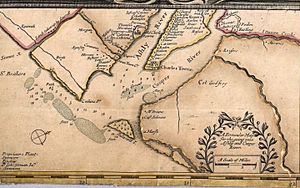Charleston Harbor facts for kids
The Charleston Harbor is a large inlet of the Atlantic Ocean located in Charleston, South Carolina. It covers about 8 square miles (20.7 square kilometers). This important waterway is formed where the Ashley and Cooper rivers meet. The entrance to the harbor is protected by Morris and Sullivan's Island. Charleston Harbor is also a key part of the Intracoastal Waterway, which is like a highway for boats along the coast.
Like many river mouths in the southeastern United States, Charleston Harbor is part of a "drowned coastline." This means that the land here was once higher, but the sea level has risen over a long time, causing the ocean to flood the river valleys.
Contents
A Look Back: History of Charleston Harbor
Charleston Harbor has played a big role in American history. It is famous for being the home of Fort Sumter, where the very first shots of the American Civil War were fired.
The harbor also saw a groundbreaking event during the Civil War. On February 17, 1864, the H.L. Hunley, a Confederate submarine, made the first successful submarine attack in history. It bravely attacked the Union ship USS Housatonic at night, sinking it.
Deepening the Harbor for Big Ships

The natural depth of Charleston Harbor was about 12 feet, which was good for ships a long time ago. This depth was a major reason why Charleston grew into an important city and port.
In 1852, the U.S. government decided to make the harbor channels deeper, aiming for 17 feet. This work was stopped by the Civil War but finished afterward. Later, between 1878 and 1886, large jetties (long walls built into the water) were constructed at the harbor entrance to help keep the channel clear.
Charleston Harbor Today: Transportation and Trade
Today, Charleston Harbor is a busy place for shipping and trade. It has public terminals run by the South Carolina Ports Authority, as well as private terminals. The main shipping channels are currently dredged to a depth of 45 feet below the average low tide.
However, this depth isn't quite enough for the very largest ships, known as Post-Panamax ships, which can now travel through the expanded Panama Canal. These huge ships often have to carry less cargo or wait for high tide to enter the port.
Making the Harbor Even Deeper
To handle these bigger ships, the U.S. Army Corps of Engineers started a project in 2015 to deepen the channels to 52 feet. This project was inspired by the recent expansion of the Panama Canal, allowing larger ships to travel more easily.
As of 2017, this deepening project was expected to cost around $500 million, with a large part of the funding coming from the federal government. Port officials have a goal to make Charleston Harbor the deepest harbor on the East Coast. This will allow even the biggest cargo ships to come and go without problems, helping trade and the economy.



